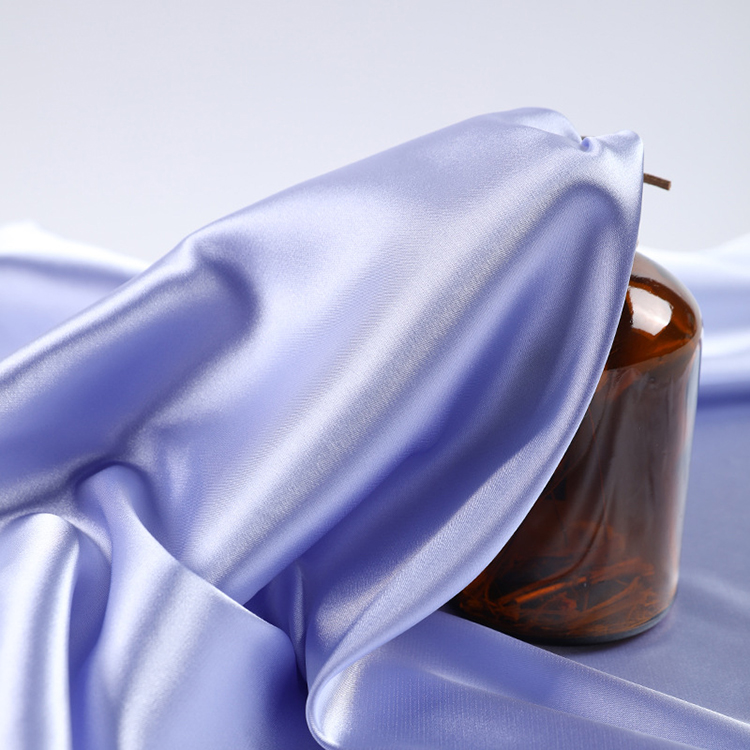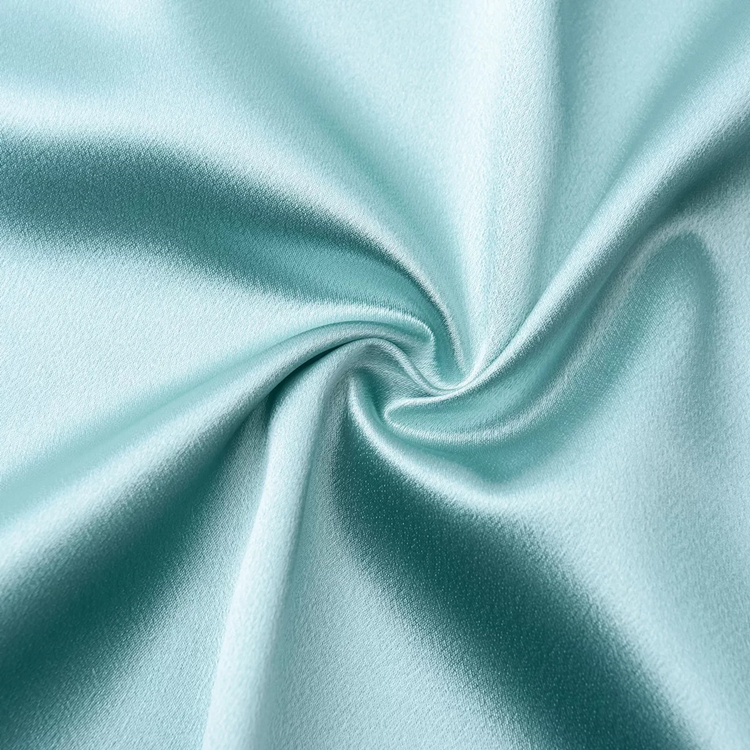How to Choose the Perfect Satin Fabric: A Comprehensive Guide
Satin fabric, renowned for its smooth surface, lustrous sheen, and luxurious feel, is a staple in fashion, home decor, and accessories. From elegant wedding gowns to sumptuous bedding, satin adds a touch of sophistication to any item. However, not all satin fabrics are created equal. With a wide range of materials, finishes, and qualities available, choosing the right satin can be a daunting task. This guide will walk you through the key factors to consider, ensuring you select the perfect satin fabric for your needs.

1. Understanding Satin: The Basics
Before diving into the selection process, it’s essential to understand what satin is. Satin is not a material but a weave. It features a distinctive weave structure where the warp (lengthwise) or weft (crosswise) threads float over several weft or warp threads, creating a smooth, glossy surface on one side and a duller, matte underside. This unique weave gives satin its characteristic sheen and softness.

2. Material Matters: Types of Satin Fabrics
The material of the satin fabric significantly impacts its appearance, feel, durability, and price. Here are the most common types:
- Silk Satin: Crafted from natural silk fibers, silk satin is the epitome of luxury. It offers a soft, smooth, and breathable feel, with a subtle, elegant sheen. Silk satin drapes beautifully, making it ideal for high – end garments like evening gowns and lingerie. However, it is delicate, prone to wrinkling, and requires gentle care. It is also the most expensive option.
- Polyester Satin: A popular and affordable alternative, polyester satin is made from synthetic fibers. It has a bright, shiny appearance and is more resistant to wrinkles, stains, and fading compared to silk. Polyester satin is easy to care for, machine – washable, and widely used in costumes, home decor, and everyday clothing. However, it may lack the natural softness of silk and can feel slightly slippery.
- Nylon Satin: Known for its strength and elasticity, nylon satin is often used in activewear, sportswear, and outerwear. It has a similar sheen to polyester satin but is more lightweight and moisture – wicking. Nylon satin is durable, resistant to abrasion, and can withstand frequent use and washing.
- Blended Satin: Blended satin fabrics combine different materials, such as silk and polyester or cotton and polyester, to offer the best of both worlds. These blends can provide a balance between the softness of natural fibers and the durability and affordability of synthetic ones. Blended satin is a versatile option suitable for a variety of applications.
Pro Tip: Check the fabric label for the material composition. If you’re unsure, you can perform a simple burn test. Silk burns slowly with a smell similar to burning hair and leaves a fine, powdery ash, while polyester melts and produces a hard, black bead.

3. Gloss and Finish: Finding the Right Shine
The gloss and finish of satin fabric can vary widely, from high – shine to matte. The choice depends on your intended use and personal preference:
- High – Gloss Satin: With a mirror – like shine, high – gloss satin is eye – catching and dramatic. It is commonly used in stage costumes, evening bags, and decorative items where a bold, glamorous look is desired. However, the high shine can also make the fabric more prone to showing stains and imperfections.
- Matte Satin: Matte satin has a more subtle, understated sheen, giving it a sophisticated and elegant appearance. It is a popular choice for clothing items that require a more refined look, such as blouses, shirts, and casual dresses. Matte satin is also less likely to show dirt and wrinkles, making it a practical option for everyday wear.
- Double – Sided Satin: As the name suggests, double – sided satin has a smooth, glossy finish on both sides. This makes it ideal for items where both sides are visible, such as scarves, ties, and some types of upholstery. Double – sided satin offers versatility and a luxurious feel.
Inspection Tip: Examine the fabric in natural light to accurately assess its gloss and finish. Look for any unevenness in the shine or color variations.

4. Weight and Thickness: Matching the Fabric to the Project
Satin fabrics come in a range of weights and thicknesses, measured in grams per square meter (gsm). The weight of the fabric affects its drape, opacity, and suitability for different applications:
- Lightweight Satin (60 – 80 gsm): Lightweight satin is thin, sheer, and breathable. It is perfect for creating flowing, airy garments like summer dresses, blouses, and scarves. Lightweight satin also works well for lingerie and other delicate items.
- Medium – Weight Satin (100 – 150 gsm): Medium – weight satin strikes a balance between drape and structure. It has a more substantial feel and is suitable for formal dresses, skirts, and jackets. Medium – weight satin can also be used for home decor items like curtains and cushion covers.
- Heavyweight Satin (200 gsm and above): Heavyweight satin is thick, sturdy, and has excellent drape. It is commonly used for upholstery, bedding, and formal gowns that require a more structured and luxurious look. Heavyweight satin provides warmth and durability, making it a great choice for winter clothing and home decor.
Feel Test: Hold the fabric in your hands and feel its weight and thickness. Consider how it will drape and move when made into your desired item.

5. Application – Specific Considerations
The intended use of the satin fabric should guide your selection. Here are some application – specific tips:
Application | Recommended Satin Type | Key Requirements | Avoid These |
Wedding Gowns | Silk Satin, Heavyweight Polyester Satin | Luxurious appearance, excellent drape | Low – quality polyester with a cheap shine |
Everyday Clothing | Blended Satin, Matte Polyester Satin | Comfort, ease of care | Heavyweight satin that may be too hot |
Home Decor | Polyester Satin, Nylon Satin | Stain resistance, wrinkle resistance | Delicate silk satin that is hard to maintain |
Activewear | Nylon Satin, Stretch Polyester Satin | Elasticity, moisture – wicking properties | Silk satin, which is not durable for sports |
6. Quality Assurance: Checking for Defects
To ensure you’re getting a high – quality satin fabric, pay attention to the following details:
- Weave Quality: Examine the fabric closely for any visible flaws in the weave, such as skipped stitches, loose threads, or uneven patterns. A high – quality satin should have a consistent, smooth weave.
- Colorfastness: Rub a white cloth gently against the satin fabric to check for color transfer. High – quality satin should not bleed or fade easily.
- Seam and Edge Finish: If the fabric has seams or edges, check that they are neatly finished. Poorly finished seams can fray and affect the overall quality of the fabric.
7. Price vs. Quality: Making an Informed Decision
Satin fabrics can range in price from very affordable to extremely expensive. While price is often an indicator of quality, it’s not always the case. Consider the following:
- Silk Satin: Expect to pay a premium for silk satin, as it is a natural and luxurious material. Prices can range from \(20 to \)100 per meter.
- Polyester Satin: Polyester satin is the most budget – friendly option, with prices typically ranging from \(5 to \)20 per meter.
- Blended Satin: Blended satin falls in the middle price range, usually between \(15 and \)40 per meter, offering a good balance of quality and affordability.
Caution: Be wary of extremely cheap “silk satin” as it is likely to be a counterfeit. Always buy from reputable sellers and ask for material samples if possible.

8. Visual Guide: Images to Aid Your Selection
- Material Comparison Image: A side – by – side photo of silk, polyester, nylon, and blended satin, highlighting their differences in texture, sheen, and color.
- Gloss and Finish Image: An illustration showing the different levels of gloss, from high – shine to matte satin, to help visualize the appearance.
- Weight and Thickness Image: A visual representation of lightweight, medium – weight, and heavyweight satin fabrics, demonstrating their transparency and drape.
- Quality Inspection Image: A step – by – step infographic on how to check for weave quality, colorfastness, and seam finish.
Conclusion
Choosing the perfect satin fabric requires a combination of knowledge, careful consideration, and personal preference. By understanding the different types of satin, their characteristics, and how they relate to your intended use, you can make an informed decision. Remember to consider the material, gloss, weight, application, quality, and price to ensure you select a satin fabric that meets your expectations and brings your creative vision to life. Whether you’re a fashion designer, home decorator, or DIY enthusiast, the right satin fabric can make all the difference.



